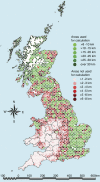Specificity of the comparative skin test for bovine tuberculosis in Great Britain
- PMID: 26338518
- PMCID: PMC4602248
- DOI: 10.1136/vr.102961
Specificity of the comparative skin test for bovine tuberculosis in Great Britain
Abstract
A novel method for estimating specificity of the Single Intradermal Comparative Cervical Tuberculin (SICCT) test for bovine tuberculosis (bTB) using surveillance tests results is reported. The specificity of the SICCT test at three cut-offs was estimated from the dates, locations and skinfold measurements of all routine tests carried out in Officially TB Free (OTF) cattle herds in Great Britain (GB) between 2002 and 2008, according to their separation (by distance and time) from known infected (OTF-withdrawn) herds. The proportion of animals that tested positive was constant (P>0.20) when the distance between tested herds and nearest infected herd exceeded 8 km. For standard cut-off, calculated specificity was 99.98 per cent (95 per cent confidence interval ±0.004 per cent), equating to one false positive result per 5000 uninfected animals tested. For severe cut-off it was 99.91 per cent (±0.013 per cent) and for ultrasevere cut-off (selecting all reactors and inconclusive reactors) it was 99.87 per cent (±0.017 per cent). The estimated positive predictive value of the test averaged 91 per cent and varied by regional prevalence. This study provides further evidence of the high specificity of the SICCT test under GB conditions, suggests that over 90 per cent of cattle currently culled using this test in GB were infected, and endorses slaughter of at least these cattle for bTB control.
Keywords: Bovine tuberculosis; Cattle; Comparative Tuberculin Skin Test; Diagnostics; Great Britain; Specificity.
British Veterinary Association.
Figures




Comment in
-
Bovine tuberculosis: how likely is a skin test reactor to be uninfected?Vet Rec. 2015 Sep 12;177(10):256-7. doi: 10.1136/vr.h4760. Vet Rec. 2015. PMID: 26358451 No abstract available.
Similar articles
-
Tuberculin manufacturing source and breakdown incidence rate of bovine tuberculosis in British cattle, 2005-2009.Vet Rec. 2013 Jan 26;172(4):98. doi: 10.1136/vr.100679. Epub 2012 Nov 16. Vet Rec. 2013. PMID: 23355712
-
Responses to diagnostic tests for bovine tuberculosis in dairy and non-dairy cattle naturally exposed to Mycobacterium bovis in Great Britain.Vet J. 2016 Oct;216:8-17. doi: 10.1016/j.tvjl.2016.06.010. Epub 2016 Jun 28. Vet J. 2016. PMID: 27687920
-
Estimation of the relative sensitivity of the comparative tuberculin skin test in tuberculous cattle herds subjected to depopulation.PLoS One. 2012;7(8):e43217. doi: 10.1371/journal.pone.0043217. Epub 2012 Aug 21. PLoS One. 2012. PMID: 22927952 Free PMC article.
-
Ante mortem diagnosis of tuberculosis in cattle: a review of the tuberculin tests, gamma-interferon assay and other ancillary diagnostic techniques.Res Vet Sci. 2006 Oct;81(2):190-210. doi: 10.1016/j.rvsc.2005.11.005. Epub 2006 Mar 2. Res Vet Sci. 2006. PMID: 16513150 Review.
-
Advances in ante-mortem diagnosis of tuberculosis in cattle.N Z Vet J. 2009 Aug;57(4):173-80. doi: 10.1080/00480169.2009.36899. N Z Vet J. 2009. PMID: 19649010 Review.
Cited by
-
Engaging With Farmers to Explore Correlates of Bovine Tuberculosis Risk in an Internationally Important Heritage Landscape: The Burren, in the West of Ireland.Front Vet Sci. 2022 Feb 15;9:791661. doi: 10.3389/fvets.2022.791661. eCollection 2022. Front Vet Sci. 2022. PMID: 35242836 Free PMC article.
-
Mycobacterium tuberculosis complex in wildlife: Review of current applications of antemortem and postmortem diagnosis.Vet World. 2020 Sep;13(9):1822-1836. doi: 10.14202/vetworld.2020.1822-1836. Epub 2020 Sep 9. Vet World. 2020. PMID: 33132593 Free PMC article. Review.
-
The History of In Vivo Tuberculin Testing in Bovines: Tuberculosis, a "One Health" Issue.Front Vet Sci. 2018 Apr 9;5:59. doi: 10.3389/fvets.2018.00059. eCollection 2018. Front Vet Sci. 2018. PMID: 29686992 Free PMC article. Review.
-
Comparative performance and age dependence of tuberculin and defined antigen bovine tuberculosis skin tests assessed with Bayesian latent class analysis.Sci Rep. 2025 Jun 5;15(1):19728. doi: 10.1038/s41598-025-05223-6. Sci Rep. 2025. PMID: 40473835 Free PMC article.
-
A cross-sectional epidemiological investigation of nontuberculous mycobacteria of public health importance in slaughter camels in Samburu County, Kenya.Trop Anim Health Prod. 2020 Mar;52(2):661-669. doi: 10.1007/s11250-019-02054-2. Epub 2019 Aug 26. Trop Anim Health Prod. 2020. PMID: 31448381
References
-
- ADVISORY COMMITTEE ON THE MICROBIOLOGICAL SAFETY OF FOOD. (2010) The possible health risks to consumers associated with Mycobacterium bovis and milk: Part 1 – Pasteurised milk and milk products. Report ID ACM/995 http://acmsf.food.gov.uk/sites/default/files/multimedia/pdfs/committee/a..., (accessed 23 Sep 2014)
-
- AHMED A. (2013) Fisher's Exact Test Calculator (2×2 Contingency Table). http://scistatcalc.blogspot.co.uk/2013/11/fishers-exact-test-calculator.... (accessed 28 Aug 2014)
-
- ANIMAL AND PLANT HEALTH AGENCY (APHA). (2014) Bovine tuberculosis: Infection status in cattle in GB, Annual surveillance report for the period January to December 2013. Published by the Animal Health and Veterinary Laboratories Agency (the agency's former name). www.gov.uk/government/uploads/system/uploads/attachment_data/file/413806... (accessed 8 May 2015)
-
- CLEGG T. A., DUIGNAN A., WHELAN C., GORMLEY E., GOOD M., CLARKE J., TOFT N. & MORE S. J. (2011) Using latent class analysis to estimate the test characteristics of the γ-interferon test, the single intradermal comparative tuberculin test and a multiplex immunoassay under Irish conditions. Veterinary Microbiology 151, 68–76 10.1016/j.vetmic.2011.02.027 - DOI - PubMed
-
- COAD M., CLIFFORD D., RHODES S. G., HEWINSON R. G., VORDERMEIER H. M. & WHELAN A. O. (2010) Repeat tuberculin skin testing leads to desensitisation in naturally infected tuberculous cattle which is associated with elevated interleukin-10 and decreased interleukin-1 beta responses. Veterinary Research 41, 14 10.1051/vetres/2009062 - DOI - PMC - PubMed
Publication types
MeSH terms
LinkOut - more resources
Full Text Sources
Other Literature Sources

